Correct Answer

verified
the corresponding an...View Answer
Show Answer
Correct Answer
verified
View Answer
Multiple Choice
Which of the following is a keto-enol tautomeric pair? 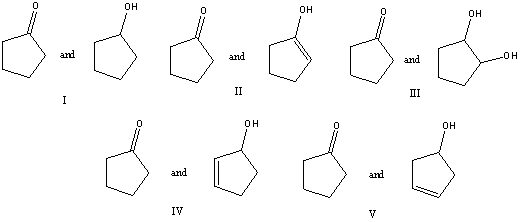
A) I
B) II
C) III
D) IV
E) V
Correct Answer

verified
Correct Answer
verified
Multiple Choice
What would be the major product of the following reaction? 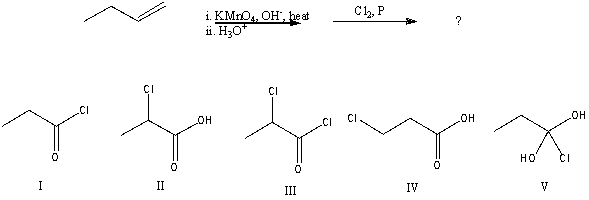
A) I
B) II
C) III
D) IV
E) V
Correct Answer

verified
Correct Answer
verified
Multiple Choice
Which is the most acidic hydrogen in the compound shown? 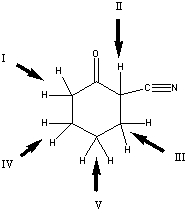
A) I
B) II
C) III
D) IV
E) V
Correct Answer

verified
Correct Answer
verified
Multiple Choice
What product is finally formed when the initial compound formed from cyclohexanone and morpholine is mixed with methyl iodide and that product is heated and then hydrolyzed? 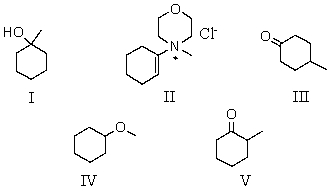
A) I
B) II
C) III
D) IV
E) V
Correct Answer

verified
Correct Answer
verified
Essay
Compounds having two carbonyl groups separated by a carbon atom are called ___.
Correct Answer

verified
 -dicarbony...
-dicarbony...View Answer
Show Answer
Correct Answer
verified
View Answer
Short Answer
Diastereomers that differ in configuration at only one stereogenic center are sometimes called ___,and their interconversion is called ___.
Correct Answer

verified
epimers; e...View Answer
Show Answer
Correct Answer
verified
View Answer
Multiple Choice
Considering only the highlighted hydrogens,list the following compounds in order of decreasing acidity: 
A) I,II,III,IV,V
B) II,V,III,I,IV
C) IV,I,III,II,V
D) IV,V,II,I,III
E) V,IV,III,II,I
Correct Answer

verified
Correct Answer
verified
Multiple Choice
What would be the major product of the following reaction? 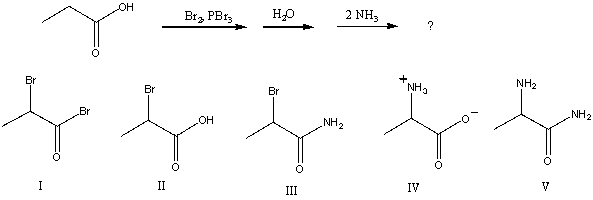
A) I
B) II
C) III
D) IV
E) V
Correct Answer

verified
Correct Answer
verified
Multiple Choice
Which is the most acidic hydrogen in the compound shown? 
A) I
B) II
C) III
D) IV
E) V
Correct Answer

verified
Correct Answer
verified
Multiple Choice
Which compound would be formed when 2-methylbutanal is treated with a solution of D+ in D2O?
A) ![]()
B) ![]()
C) ![]()
D) ![]()
E) ![]()
Correct Answer

verified
Correct Answer
verified
Multiple Choice
The conversion of  is accomplished by the use of which oxidizing agent?
is accomplished by the use of which oxidizing agent?
A) Ag(NH3) 2+
B) O3
C) NaOBr (Br2 in NaOH)
D) ![]()
E) Cu2+
Correct Answer

verified
Correct Answer
verified
Multiple Choice
What synthetic strategy would accomplish the following transformation? 
A) i) Br2,H3O+; ii) NaOC2H5,C2H5OH,heat
B) i) Cl2,FeCl3; ii) NaOC2H5,C2H5OH,heat
C) i) HCN; ii) H3O+,heat
D) i) Br2,h ; ii) (CH3) 3COK,(CH3) 3COH,heat
E) None of these choices.
Correct Answer

verified
Correct Answer
verified
Multiple Choice
Which is the most acidic hydrogen in the compound shown? 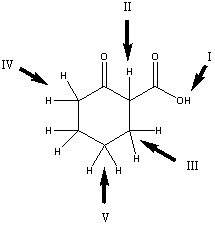
A) I
B) II
C) III
D) IV
E) V
Correct Answer

verified
Correct Answer
verified
Multiple Choice
What would be the major product of the following reaction sequence? 
A) I
B) II
C) III
D) IV
E) V
Correct Answer

verified
Correct Answer
verified
Multiple Choice
Which of these compounds would exist primarily in an enol form?
A) ![]()
B) ![]()
C) ![]()
D) ![]()
E) ![]()
Correct Answer

verified
Correct Answer
verified
Multiple Choice
Which reagent would best serve as the basis for a simple chemical test to distinguish between 
A) NaOI (I2 in NaOH)
B) Br2/CCl4
C) CrO3/H2SO4
D) NaHCO3/H2O
E) Ag(NH3) 2+
Correct Answer

verified
Correct Answer
verified
Multiple Choice
Which compound would be formed when 2-methylbutanal is treated with a solution of NaOT in T2O?
A) ![]()
B) ![]()
C) ![]()
D) ![]()
E) ![]()
Correct Answer

verified
Correct Answer
verified
Essay
What is the final product of the following reaction sequence? Give structural details of all significant intermediates. 
Correct Answer

verified
Correct Answer
verified
Multiple Choice
Which of the following represent keto-enol tautomers?
A) ![]()
B) ![]()
C) ![]()
D) More than one of these choices.
E) None of these choices.
Correct Answer

verified
Correct Answer
verified
Showing 121 - 140 of 190
Related Exams